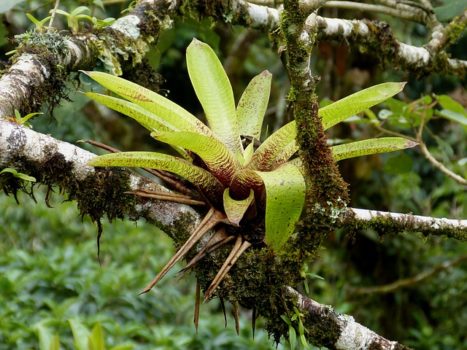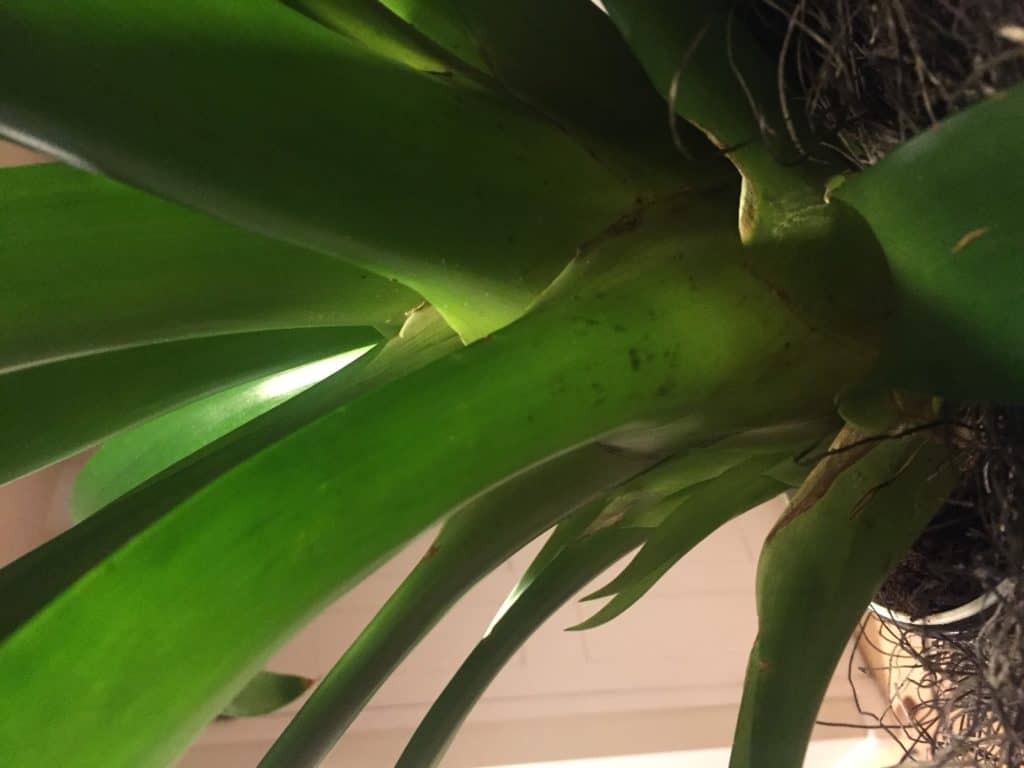We received a beautiful plant for Christmas this year called a bromeliad. These tropical plants are exceptionally colorful, and are often gifted for weddings, holidays or special life events. They are relatively easy to care for and can last for years if you know what you’re doing. Let’s see how to take care of them and enjoy them for years to come.
The holiday of all holidays has passed and we are again easing into a regular routine. The house has been put back in order, but this year something is different. We had many guests come to our home, most left after a period of time, but one decided to stay. As is customary we like to call our guests by their first name and so our official new roomie answers to the name of “Bromie”.
WHO OR WHAT IS “BROMIE”
Our guest has an official name of Bromeliad and is a relative of the orchid plant and the pineapple plant and originates in the South American tropical forests. They can be found hanging on trees and limbs of cactus, but also on the forest floor. Certain species of Bromies have been cultivated to be excellent house plants.

These beautiful tropical plants are very fine house guests because they require little care and upkeep. Bromeliad plants are often epiphytic and cling to trees or other structures. They are not parasitic, but simply use the structures as perches from which to gather sun and moisture. Some bromeliads grow well as air plants or tillandsia plants.
WHAT DOES OUR “BROMIE” LOOK LIKE

This exotic plant adds COLOR to any room. It comes in several varieties and each one has a particular look, color and personality. Our visitor is called Guzmanias and has dark green leaves are in the shape of a spike with a rounded cup at the area where it joins the flower stem. Some of the leaves are 18 to 24 inches and in the center is this gorgeous spire that is almost two feet tall and the most beautiful bright red. This is where the flowers appear when the plant is ready to bloom.

Each variety of bromeliads has its own special look, some with short very colorful leaves such as the Aneoregelias variety with a small center cup for water. Another variety called the Pink Quill plant has very thin leaves, much like the daffodil, and produces a center single leaf, much like a feather hence the name. This center leaf is bright pink and the flower of this variety is a striking lavender. One of the most popular bromies is the Aechmea Fasciata. This captivating plant has variegated spikes for leaves (rather short and fat). The center produces a bright pink plume that remains colorful until the plant produces small flowers.

GROWING CONDITIONS FOR THE “BROMIES”
At first glance this beautiful house plant looks like it would require a significant amount of tender care with a high degree of maintenance, BUT NO . . . a place where there is significant diffused light and temperatures between 60 and 80 degrees. Direct sun will burn the leaves. Since bromeliads need little or no soil to grow, the plant gets its nourishment from the water it receives. Most plants have a center “cup” that holds the water that the plant uses. Some just get water from the center of the leaves where they attach to the flower stock. If there is any soil around the bottom of the plant, it should also be damp, but not wet.
When growing these spectacular plants, set their roots in shallow potting soil that is used for orchids or a bromeliad potting mix. It can also be a blend of bark and sphagnum moss. The pot should be shallow. Again, do not over water. Every week or two, empty the water that remains in the center bowl or leaves. Make sure that the pot has drainage.
If the air in your home happens to be a bit dry, the Bromie would appreciate being set upon a bed of pebbles that have water in the bottom of their tray. This would provide the humidity that would help this plant thrive. Bromeliad plant care is easy and requires no special tools or fertilizers. Feed the plants with a half strength fertilizer each month in the growing season (usually during the spring and early summer).
BROMELIAD LIFE CYCLE
This plant has a life cycle that is usually four or more years. It takes a good two years to get the plant to a mature stage. As the plant matures the color becomes more apparent in the leaves of the plant. Each type of “bromie” has its own distinct shape.
- The Pink Quillplant usually only gets about 12 inches.
- The Neoregelias are smaller, usually 8 to 10 inches and about 10 inches across.
- The Queen’s Tearsis a rainbow-colored plant that produces upright clumps of trumpet-shaped, grayish-green leaves. Arching stems bear pink bracts and line green petals rimmed in royal blue.
Each long-lasting flower displays a long yellow stamen. As each bromeliad flowers, their presentation of the blooms is different, but this usually signals the beginning of the end.
WHAT TO DO WITH A LITTER OF “PUPS”
But not to fear. As the colorful stocks begin to fade, inspect around the plant. Bromies produce offspring called “pups”. Though bromeliad can be reproduced by seed, it is a long and arduous process to get fertile seed and it usually takes about 6 years to produce a plant.
So, take note of the little growths that will appear around the base of the plant. The plants will take nourishment from the mother and as they grow, she will fade away. There will come a time when the mother stock will be all brown. Just trim it out and start naming your new litter of pups. Some plants have been known to produce as many as seven pups.


Here is how to take care of your pups:
- When the pup is about 1/3 the size of the mother plant, you can separate it from the mother by using a sharp knife or blade.
- After separation put the pup in a shallow pot with a potting mix for bromeliads or orchids.
- Dampen the growing medium and make sure the pup has a good draining system.
- Continue with watering in the cup of the plant. The water is about ¼ of a cup.
- Add diluted fertilizer to get it started.
- If the pup is going to stay in the original pot, the mother can be transplanted to another pot and more pups may develop before the mother stock is completely ready for the compost pile.
- Be sure and have a proper funeral and burial for your family member.
A NEW HOME FOR BROME
Your bromeliad plant will probably not need to be replanted, but maybe every four or five years. Then only maybe a pot that is one or two sizes bigger. This house plant does not grow fast. If you have several pups you have transplanted into individual pots, it will take two or three years to develop a mature plant.
Repot your plant in the warmer months, not the cooler ones while the roots are taking a bit of a siesta. Their life span will probably be four to six years, so give them a name, a place to call their own and talk to them.
They are a bit vain, so love to hear how beautiful they are. You will love to hear the oohs and aahs or your human visitors as well.
AUNTS AND UNCLES OF YOUR BROME
There are several names of the various types of bromeliads. Oueen’s Tears is a unique plant and is sometimes called the friendship plant. The Pink Quill plant always gets a second glance with its unusual foliage. Colorful indoor gardens are developed with Neoregelias and they enjoy group gatherings. The bright flower and variegated leaves of the Aechmea Fasciata is always welcomed whether it is a family gathering or an honored guest status. Perhaps most regal of all is the stately Guzmanias (my favorite) and she proves to be an appreciated part of our family. All in all, this has been a most spectacular holiday with our new family member.
DO “PUPS” AND KITTIES GET ALONG
If you have a love for living things and I assume you do if you find “bromies” interesting and have chosen to make a place in your home for them, then you probably have other living creatures with four legs that share your domicile. Like a kitty cat or puppy dog.

Your litter of bromeliad pups can be contained in pots to meet their size (shallow and about 1 to 2 inches bigger around than the pup). But four-legged kitties can find intrigue and adventure around any and all of your bromeliad plants. They also figure that the beautiful leaves are there for lunch. Don’t worry. These leaves are not harmful in any way – at least your cats or dogs. You may have to curb the lunch crowd if your plant is showing any signs of stress.
TO PRUNE OR NOT TO PRUNE
That is the question. The bromeliad plant does not need any pruning or training by cutting in its growth pattern. If a leaf starts to go brown, just sever it from the main plant. The center stock and flower will eventually fade and go brown. Then you will need to trim it out being careful of any pups that are attached. Some mother plants will host several pups and may need to be transplanted until all the pups are weaned and on their own. The life of a “Brome” can be from four to eight years.

